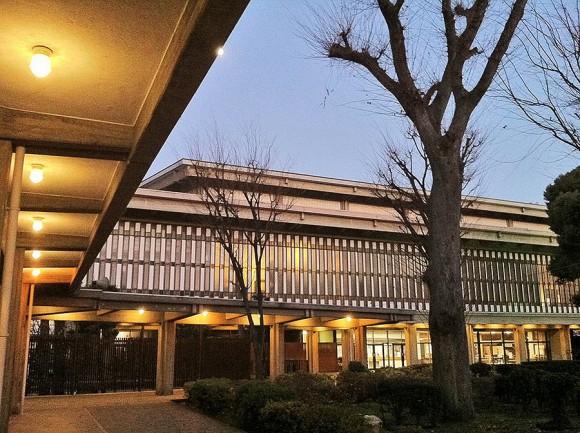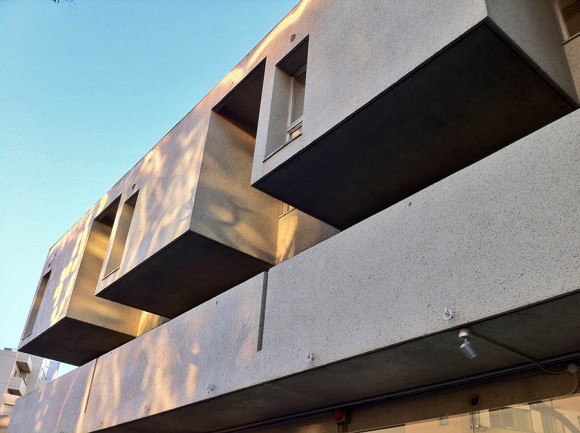With Ichibankan (“Building Number One”) and Nibankan (“Building Number Two”), Minoru Takeyama created two postmodernist icons in a part of Shinjuku that is generally known for its sleazy nighttime buzz. Its nondescript buildings usually only come to life at night when they’re illuminated by neon advertising lights. Takeyama’s towers, however, carry some of that “charm” into the daytime.
Category Archives: Architecture
Happy New Year
We flew to Okinawa over the new year to escape the (admittedly mild) winter here in Tokyo for a few days. The weather held up to its reputation (we even swam in the ocean!), the beaches were beautiful and the food tasty. Now back in Tokyo, it’s time for me to put up a few pictures of the trip and look back at the first three months of my blogging here.

American military plane in landing approach Continue reading
Sky House
A short walk away from Tokyo’s Gokokuji station, Kiyonori Kikutake’s Sky House (1958) is a small yet very important residential building in Japanese post-war architectural history. Here, important early meetings took place between the Metabolists, of which Kikutake was a founding member. The architect himself lived here until his death last year.
Jyo-Senji
Jyo-Senji is a temple of the Hommon Butsuryu sect of Nichiren Buddhism. It can be found near Shibuya station, on the way towards Daikanyama. It was built in 1965 and stands in stark contrast to the Reiyukai temple I visited earlier. Its courtyard arrangement, with classrooms, offices and several halls, invites associations of community rather than awe and authority.
Gunkan Higashi Shinjuku
This 1970 building is also known as Sky Building No. 3 and (much more fittingly) the Battleship Building. Situated on a main road in Tokyo’s Shinjuku district, it is a colossal work by the eccentric late Yoji Watanabe who used to serve as a naval officer during WWII. This 14-story building has defied the fate of many other buildings from the 1970s, that is it got a complete makeover and avoided destruction.
Hillside Terrace Daikanyama
Fumihiko Maki is another Japanese architect of international repute. His buildings include major universities and other public spaces around the world, but – in his words – no other project “has occupied my thoughts so continuously over time as Hillside Terrace has.” Hillside Terrace is a series of pretty mixed-use buildings in Tokyo’s trendy Daikanyama district. The fascinating aspect about it is that this is one large set of buildings that, unlike the vast majority of Tokyo, has seen consistency during the four decades of its genesis.
Azuma-tei (aka Tower House)
Easily one of Tokyo’s most beloved buildings, it is easy to walk past it at first. This architect’s residence near Gaiemmae station is very small: It is built on a leftover plot of just 20.5 square meters. The actual building surface is even smaller. The house’s six (!) levels provide just 65 square meters of living space, including a rooftop terrace and a carport. Most surprising, however, is the house’s vintage: It was built in 1966/1967.
Villas near Aoyama / Shibuya
Update (27 Dec 2012): Zoe from Japan Property Central has sent me the link to the Villas’ website (in Japanese). She also says that “there are a faction of people who do like older ‘vintage’ apartments because of their space and character. Many of the Villa buildings are mixed-use and attract a lot of people in the design field who are looking for a trendy office. Because of their age, they are less expensive on a square meter basis, while still being in very convenient locations.”
Tokyo lacks a core of seriously old buildings mainly due to the destruction wrought by the 1923 Kanto earthquake and WWII. Newer apartments carry a premium over ones in older buildings. There is little in the way of preservation. This is why the face of the city is constantly changing. [For a more vivid discussion of the fluidity of Tokyo’s cityscape, I recommend this BBC documentary on Youtube.]
All of the above is why one assumes buildings in Tokyo to be no older than 20-30 years. I was thus happy to stumble upon this real estate website listing the coordinates of several “villas” (i.e. apartment blocks) in Aoyama and Shibuya that are from the 1960s and 1970s and have withstood the normal build and tear-down cycle at least once. They all have fantastically mediterranean names. I took a walk yesterday to have a look.
Villa Rosa – 1969: The most dilapidated of the villas, with seemingly no major renovation having occurred since it got built more than forty years ago. All flats / offices enjoy ample daylight.
The Tokyo Mormon Temple
The leafy neighbourhood of Azabu is one of Tokyo’s most upscale residential districts, home to many embassies and expensive apartment blocks. It is also the site of Tokyo’s Mormon temple, or Japan’s Temple of the Church of Jesus Christ of Letter-Day Saints as it is formally known. It is an imposing and slightly surreal sight.
St. Mary’s Cathedral
Kenzo Tange is perhaps the most famous international architect from Japan. He embodies the country’s post-war history like no other: the struggle for the country’s own identity amid the unprecedented economic miracle, the search for symbolism and spiritual space in architecture, all this (and more) can be seen in his works. I went to see his St. Mary’s Cathedral in Bunkyo Ward today.








